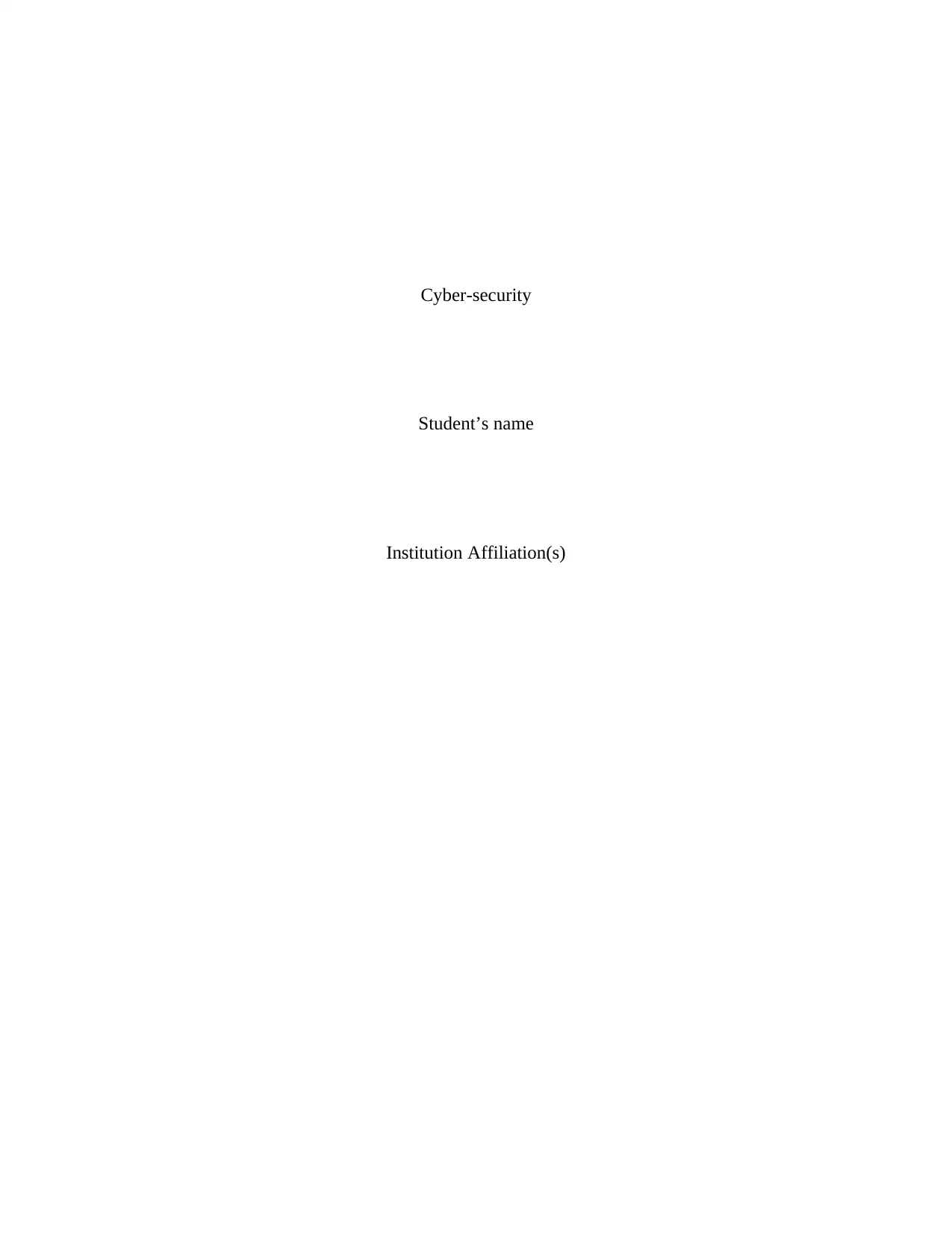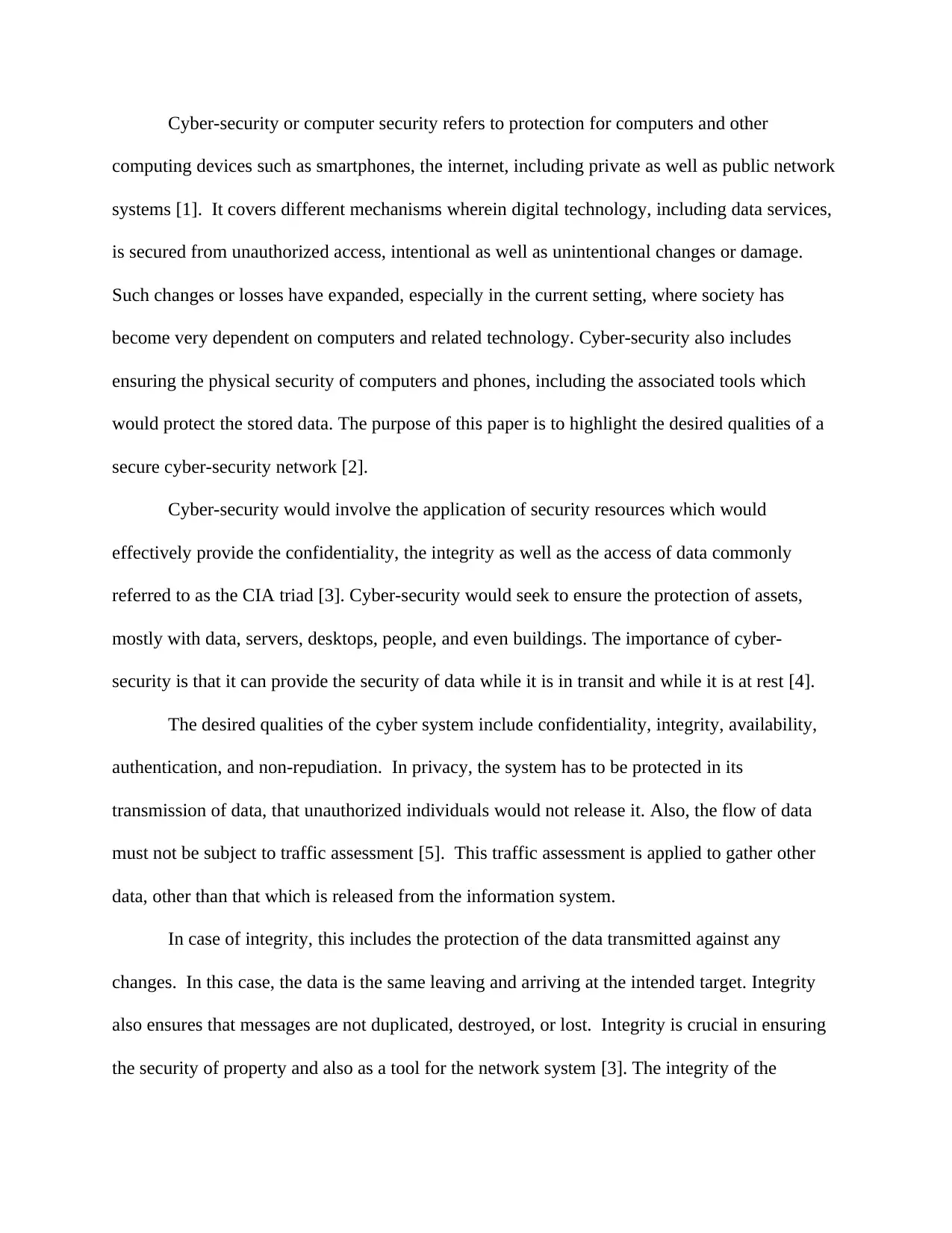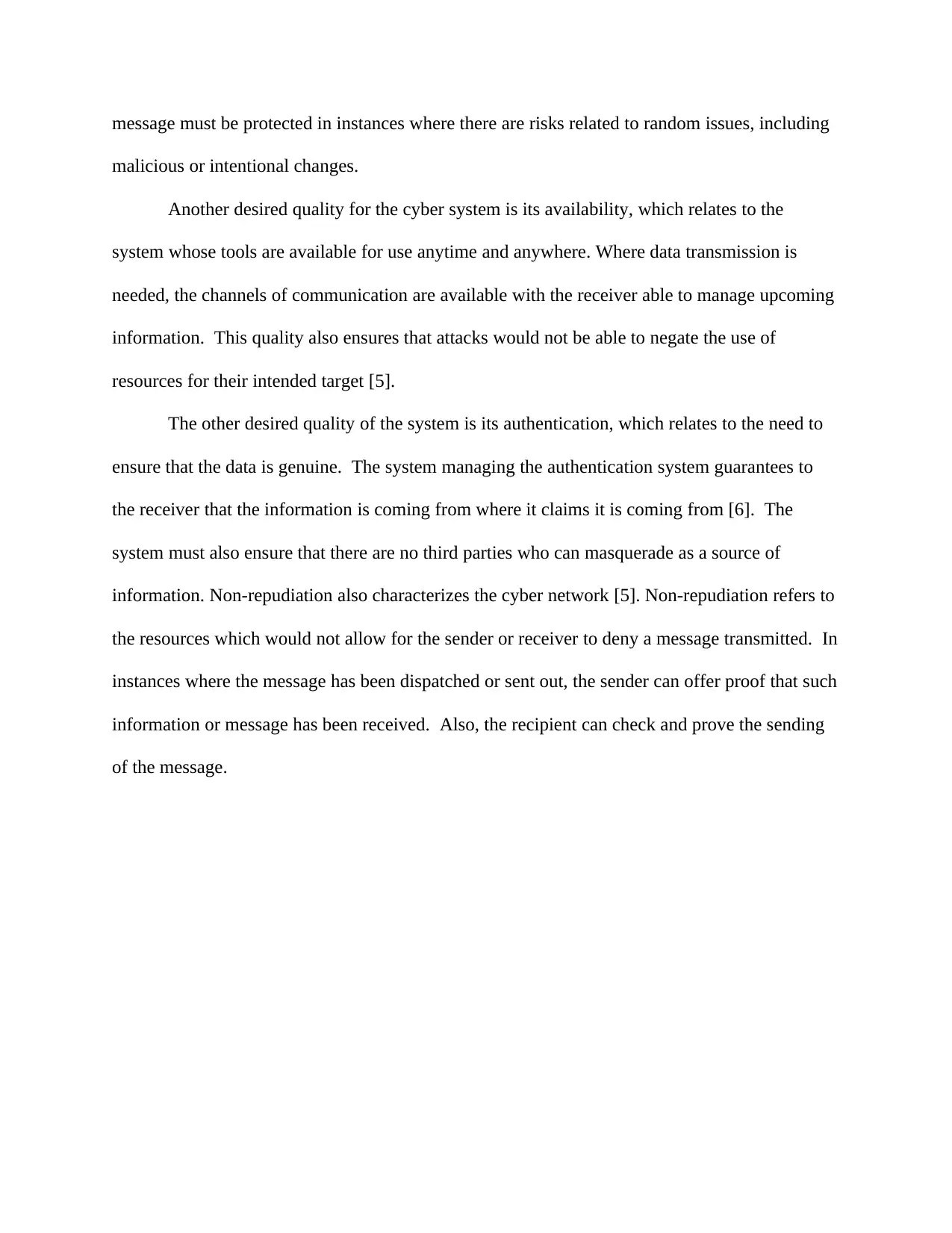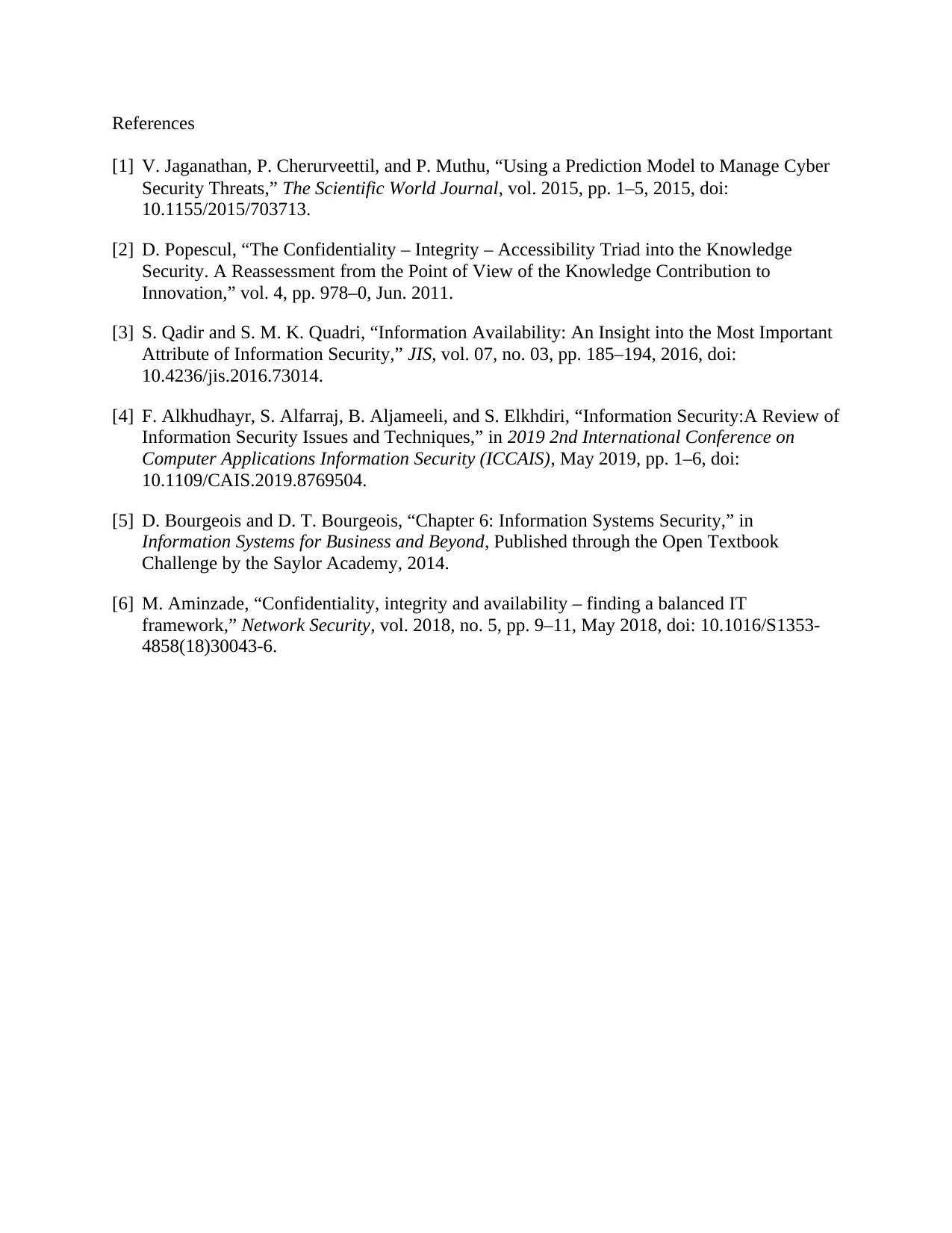Cybersecurity Network: Essential Qualities and Characteristics Report
VerifiedAdded on 2022/09/12
|4
|890
|8
Report
AI Summary
This report provides an overview of the desired qualities of a secure cybersecurity network. It begins by defining cybersecurity and its importance in protecting digital assets and data, emphasizing the CIA triad (confidentiality, integrity, and availability). The report delves into specific qualities, including confidentiality, ensuring data protection during transmission; integrity, safeguarding data against unauthorized changes; availability, guaranteeing system and resource accessibility; authentication, verifying data genuineness; and non-repudiation, preventing message denial. Each quality is explained in detail, highlighting its role in maintaining a robust and secure network environment, essential in today's technology-dependent world. The report references several sources to support its assertions.

Cyber-security
Student’s name
Institution Affiliation(s)
Student’s name
Institution Affiliation(s)
Paraphrase This Document
Need a fresh take? Get an instant paraphrase of this document with our AI Paraphraser

Cyber-security or computer security refers to protection for computers and other
computing devices such as smartphones, the internet, including private as well as public network
systems [1]. It covers different mechanisms wherein digital technology, including data services,
is secured from unauthorized access, intentional as well as unintentional changes or damage.
Such changes or losses have expanded, especially in the current setting, where society has
become very dependent on computers and related technology. Cyber-security also includes
ensuring the physical security of computers and phones, including the associated tools which
would protect the stored data. The purpose of this paper is to highlight the desired qualities of a
secure cyber-security network [2].
Cyber-security would involve the application of security resources which would
effectively provide the confidentiality, the integrity as well as the access of data commonly
referred to as the CIA triad [3]. Cyber-security would seek to ensure the protection of assets,
mostly with data, servers, desktops, people, and even buildings. The importance of cyber-
security is that it can provide the security of data while it is in transit and while it is at rest [4].
The desired qualities of the cyber system include confidentiality, integrity, availability,
authentication, and non-repudiation. In privacy, the system has to be protected in its
transmission of data, that unauthorized individuals would not release it. Also, the flow of data
must not be subject to traffic assessment [5]. This traffic assessment is applied to gather other
data, other than that which is released from the information system.
In case of integrity, this includes the protection of the data transmitted against any
changes. In this case, the data is the same leaving and arriving at the intended target. Integrity
also ensures that messages are not duplicated, destroyed, or lost. Integrity is crucial in ensuring
the security of property and also as a tool for the network system [3]. The integrity of the
computing devices such as smartphones, the internet, including private as well as public network
systems [1]. It covers different mechanisms wherein digital technology, including data services,
is secured from unauthorized access, intentional as well as unintentional changes or damage.
Such changes or losses have expanded, especially in the current setting, where society has
become very dependent on computers and related technology. Cyber-security also includes
ensuring the physical security of computers and phones, including the associated tools which
would protect the stored data. The purpose of this paper is to highlight the desired qualities of a
secure cyber-security network [2].
Cyber-security would involve the application of security resources which would
effectively provide the confidentiality, the integrity as well as the access of data commonly
referred to as the CIA triad [3]. Cyber-security would seek to ensure the protection of assets,
mostly with data, servers, desktops, people, and even buildings. The importance of cyber-
security is that it can provide the security of data while it is in transit and while it is at rest [4].
The desired qualities of the cyber system include confidentiality, integrity, availability,
authentication, and non-repudiation. In privacy, the system has to be protected in its
transmission of data, that unauthorized individuals would not release it. Also, the flow of data
must not be subject to traffic assessment [5]. This traffic assessment is applied to gather other
data, other than that which is released from the information system.
In case of integrity, this includes the protection of the data transmitted against any
changes. In this case, the data is the same leaving and arriving at the intended target. Integrity
also ensures that messages are not duplicated, destroyed, or lost. Integrity is crucial in ensuring
the security of property and also as a tool for the network system [3]. The integrity of the

message must be protected in instances where there are risks related to random issues, including
malicious or intentional changes.
Another desired quality for the cyber system is its availability, which relates to the
system whose tools are available for use anytime and anywhere. Where data transmission is
needed, the channels of communication are available with the receiver able to manage upcoming
information. This quality also ensures that attacks would not be able to negate the use of
resources for their intended target [5].
The other desired quality of the system is its authentication, which relates to the need to
ensure that the data is genuine. The system managing the authentication system guarantees to
the receiver that the information is coming from where it claims it is coming from [6]. The
system must also ensure that there are no third parties who can masquerade as a source of
information. Non-repudiation also characterizes the cyber network [5]. Non-repudiation refers to
the resources which would not allow for the sender or receiver to deny a message transmitted. In
instances where the message has been dispatched or sent out, the sender can offer proof that such
information or message has been received. Also, the recipient can check and prove the sending
of the message.
malicious or intentional changes.
Another desired quality for the cyber system is its availability, which relates to the
system whose tools are available for use anytime and anywhere. Where data transmission is
needed, the channels of communication are available with the receiver able to manage upcoming
information. This quality also ensures that attacks would not be able to negate the use of
resources for their intended target [5].
The other desired quality of the system is its authentication, which relates to the need to
ensure that the data is genuine. The system managing the authentication system guarantees to
the receiver that the information is coming from where it claims it is coming from [6]. The
system must also ensure that there are no third parties who can masquerade as a source of
information. Non-repudiation also characterizes the cyber network [5]. Non-repudiation refers to
the resources which would not allow for the sender or receiver to deny a message transmitted. In
instances where the message has been dispatched or sent out, the sender can offer proof that such
information or message has been received. Also, the recipient can check and prove the sending
of the message.
⊘ This is a preview!⊘
Do you want full access?
Subscribe today to unlock all pages.

Trusted by 1+ million students worldwide

References
[1] V. Jaganathan, P. Cherurveettil, and P. Muthu, “Using a Prediction Model to Manage Cyber
Security Threats,” The Scientific World Journal, vol. 2015, pp. 1–5, 2015, doi:
10.1155/2015/703713.
[2] D. Popescul, “The Confidentiality – Integrity – Accessibility Triad into the Knowledge
Security. A Reassessment from the Point of View of the Knowledge Contribution to
Innovation,” vol. 4, pp. 978–0, Jun. 2011.
[3] S. Qadir and S. M. K. Quadri, “Information Availability: An Insight into the Most Important
Attribute of Information Security,” JIS, vol. 07, no. 03, pp. 185–194, 2016, doi:
10.4236/jis.2016.73014.
[4] F. Alkhudhayr, S. Alfarraj, B. Aljameeli, and S. Elkhdiri, “Information Security:A Review of
Information Security Issues and Techniques,” in 2019 2nd International Conference on
Computer Applications Information Security (ICCAIS), May 2019, pp. 1–6, doi:
10.1109/CAIS.2019.8769504.
[5] D. Bourgeois and D. T. Bourgeois, “Chapter 6: Information Systems Security,” in
Information Systems for Business and Beyond, Published through the Open Textbook
Challenge by the Saylor Academy, 2014.
[6] M. Aminzade, “Confidentiality, integrity and availability – finding a balanced IT
framework,” Network Security, vol. 2018, no. 5, pp. 9–11, May 2018, doi: 10.1016/S1353-
4858(18)30043-6.
[1] V. Jaganathan, P. Cherurveettil, and P. Muthu, “Using a Prediction Model to Manage Cyber
Security Threats,” The Scientific World Journal, vol. 2015, pp. 1–5, 2015, doi:
10.1155/2015/703713.
[2] D. Popescul, “The Confidentiality – Integrity – Accessibility Triad into the Knowledge
Security. A Reassessment from the Point of View of the Knowledge Contribution to
Innovation,” vol. 4, pp. 978–0, Jun. 2011.
[3] S. Qadir and S. M. K. Quadri, “Information Availability: An Insight into the Most Important
Attribute of Information Security,” JIS, vol. 07, no. 03, pp. 185–194, 2016, doi:
10.4236/jis.2016.73014.
[4] F. Alkhudhayr, S. Alfarraj, B. Aljameeli, and S. Elkhdiri, “Information Security:A Review of
Information Security Issues and Techniques,” in 2019 2nd International Conference on
Computer Applications Information Security (ICCAIS), May 2019, pp. 1–6, doi:
10.1109/CAIS.2019.8769504.
[5] D. Bourgeois and D. T. Bourgeois, “Chapter 6: Information Systems Security,” in
Information Systems for Business and Beyond, Published through the Open Textbook
Challenge by the Saylor Academy, 2014.
[6] M. Aminzade, “Confidentiality, integrity and availability – finding a balanced IT
framework,” Network Security, vol. 2018, no. 5, pp. 9–11, May 2018, doi: 10.1016/S1353-
4858(18)30043-6.
1 out of 4
Related Documents
Your All-in-One AI-Powered Toolkit for Academic Success.
+13062052269
info@desklib.com
Available 24*7 on WhatsApp / Email
![[object Object]](/_next/static/media/star-bottom.7253800d.svg)
Unlock your academic potential
Copyright © 2020–2025 A2Z Services. All Rights Reserved. Developed and managed by ZUCOL.




